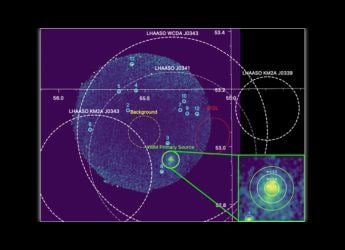- Home
- Science
- Science News
- Astronomers Capture First Image of Two Supermassive Black Holes Orbiting Each Other
Astronomers Capture First Image of Two Supermassive Black Holes Orbiting Each Other
OJ 287’s two supermassive black holes captured for the first time in a stunning image.

Photo Credit: NASA
Twin black holes spiral in NASA’s cosmic simulation
Astronomers have taken the first-ever image of a pair of supermassive black holes orbiting in a distant galaxy, taken with an observatory that could hint at even more eerie ways they can behave. This galaxy is a quasar, the brightest type of active galactic nuclei. OJ 287 is very special as it has two black holes which dance around each other every 12-year orbit. The new image shows the black holes together with the energetic particle jets. These images validate the theories about the dual core structure of the galaxy.
A Cosmic Ballet
As per NASA, OJ 287, the larger black hole is 18 billion times the mass of the Sun, whereas the smaller is about 150 million solar masses. Any neutral or positive charge currents- positive and neutral charges passing through the black holes into the disk would fall along diverging field lines, while current below 1/sqrt(3) of this value would precipitate ohmic heating in the Hall layer (Hirose et al.,2014). The smaller black hole's jet spirals, like water from a spinning garden hose, because of the pull of its larger companion's gravity.
Breakthrough Observation
For the first time, astronomers have observed a smaller black hole with the aid of joint Space and Earth observations RadioAstron telescope. Understanding how the two jets interact lets scientists mine important information about how the black hole operates: For example, that is also what could generate the gravitational waves, which are ripples in spacetime.
These are direct observations of two supermassive black holes in the act of merging. This opens new doors to learn about galaxy evolution. Continuous observations can enable astrophysicians to find the root system and know about other huge forces that shape the universe.
Get your daily dose of tech news, reviews, and insights, in under 80 characters on Gadgets 360 Turbo. Connect with fellow tech lovers on our Forum. Follow us on X, Facebook, WhatsApp, Threads and Google News for instant updates. Catch all the action on our YouTube channel.
Related Stories
- Samsung Galaxy Unpacked 2025
- ChatGPT
- Redmi Note 14 Pro+
- iPhone 16
- Apple Vision Pro
- Oneplus 12
- OnePlus Nord CE 3 Lite 5G
- iPhone 13
- Xiaomi 14 Pro
- Oppo Find N3
- Tecno Spark Go (2023)
- Realme V30
- Best Phones Under 25000
- Samsung Galaxy S24 Series
- Cryptocurrency
- iQoo 12
- Samsung Galaxy S24 Ultra
- Giottus
- Samsung Galaxy Z Flip 5
- Apple 'Scary Fast'
- Housefull 5
- GoPro Hero 12 Black Review
- Invincible Season 2
- JioGlass
- HD Ready TV
- Laptop Under 50000
- Smartwatch Under 10000
- Latest Mobile Phones
- Compare Phones
- Poco F8 Ultra
- Poco F8 Pro
- Huawei Mate 80 RS Master Edition
- Huawei Mate 80 Pro Max
- Huawei Mate 80 Pro
- Huawei Mate 80
- Huawei Mate X7
- Honor 500
- Asus ProArt P16
- MacBook Pro 14-inch (M5, 2025)
- Poco Pad M1
- Poco Pad X1
- Honor Watch X5
- Huawei Watch Ultimate 2
- Acerpure Nitro Z Series 100-inch QLED TV
- Samsung 43 Inch LED Ultra HD (4K) Smart TV (UA43UE81AFULXL)
- Asus ROG Ally
- Nintendo Switch Lite
- Haier 1.6 Ton 5 Star Inverter Split AC (HSU19G-MZAID5BN-INV)
- Haier 1.6 Ton 5 Star Inverter Split AC (HSU19G-MZAIM5BN-INV)

















